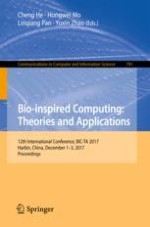2017 | Book
Bio-inspired Computing: Theories and Applications
12th International Conference, BIC-TA 2017, Harbin, China, December 1–3, 2017, Proceedings
Editors: Cheng He, Hongwei Mo, Linqiang Pan, Yuxin Zhao
Publisher: Springer Singapore
Book Series : Communications in Computer and Information Science
